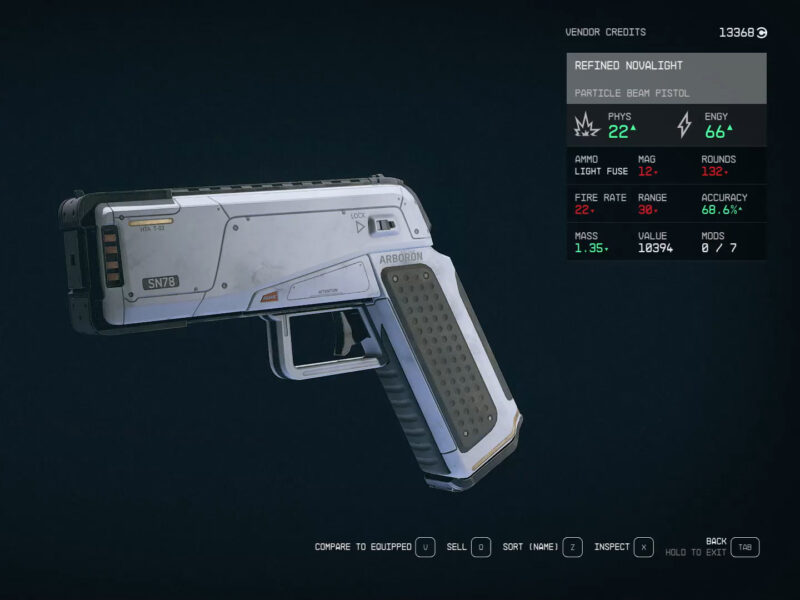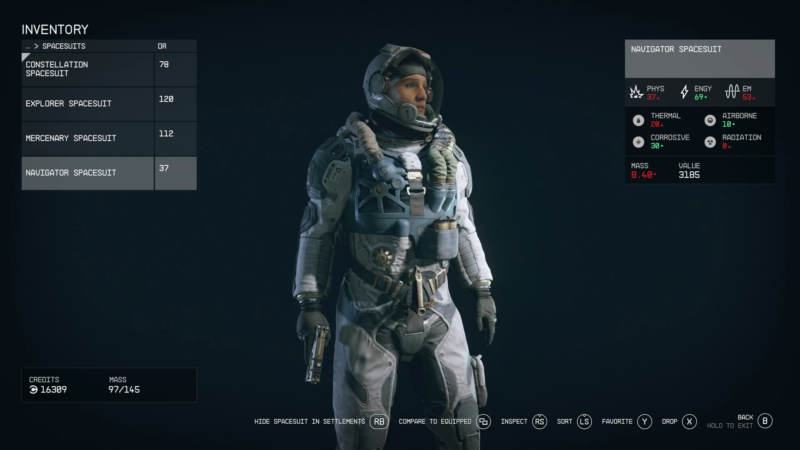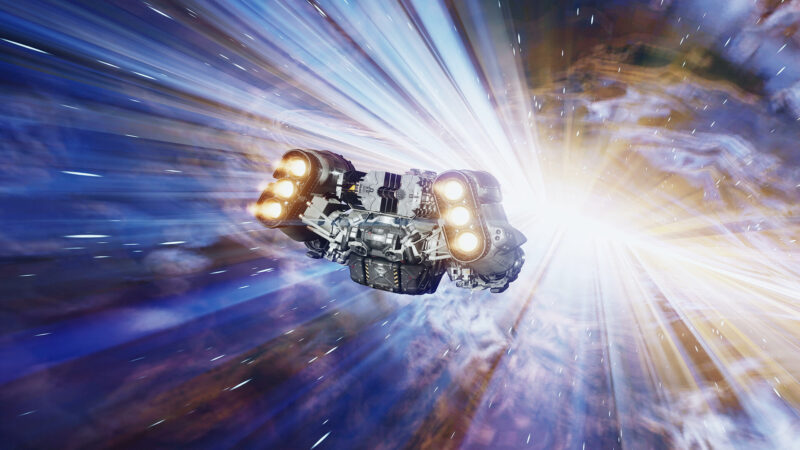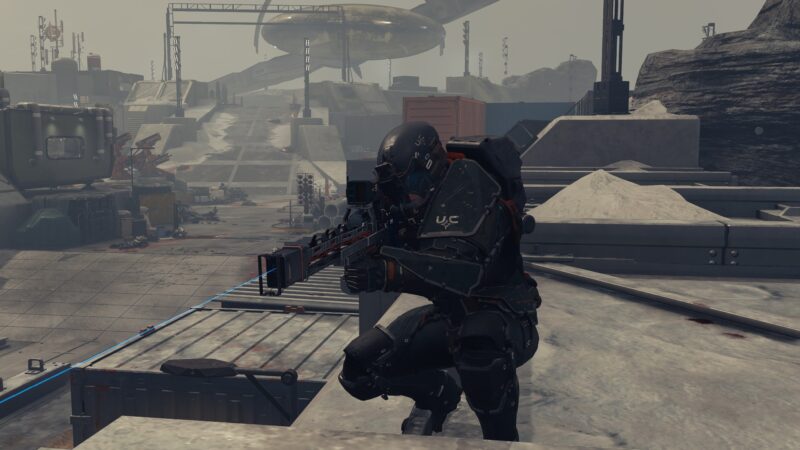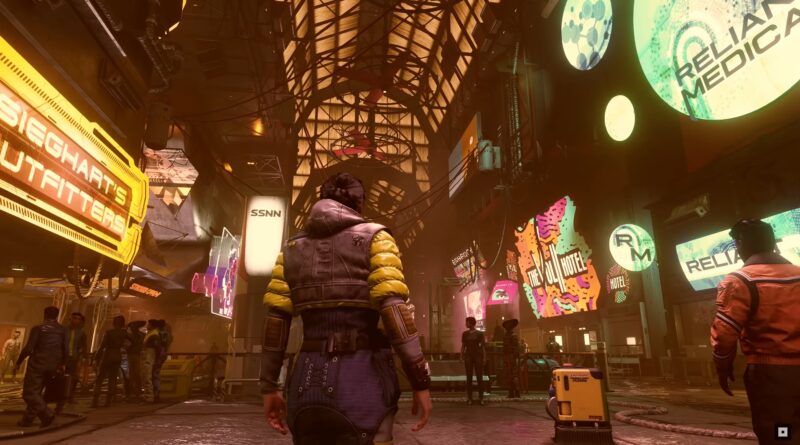This guide is for beginner Starfield players and will explain mechanics, combat, stealth, and more in our Tips I Wish I Knew First – New Player Guide!
Tips I Wish I Knew First – Starfield New Player Guide
Embarking on a cosmic journey in “Starfield,” the highly anticipated space-faring game, can be an awe-inspiring adventure filled with mystery, exploration, and discovery. As a new player venturing into the depths of this expansive universe, there are a multitude of aspects to consider that could enhance your gameplay experience from the outset. This guide aims to illuminate those valuable tips and insights that veteran players wish they had known when they first set foot aboard their interstellar vessels. Whether you’re navigating uncharted star systems, engaging in exhilarating space battles, or unearthing the secrets of distant planets, these essential pointers will undoubtedly pave the way for a more informed, enjoyable, and successful journey through the cosmos of Starfield.
1. What to Expect
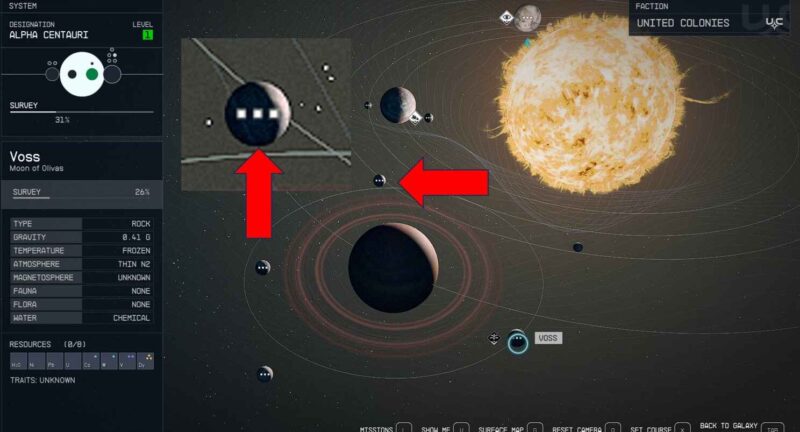
Starfield is the first new universe in 25 years from Bethesda Game Studios, the award-winning creators of The Elder Scrolls V: Skyrim and Fallout 4. Game Director Todd Howard said it would have over 1,000 planets and that it would be like ‘Skyrim in space.’ I’m honestly a bit shocked at how similar the games are, especially in the story and exploration.
I’ve beaten the main story and I’ve logged over 60 hours so far. I spent most of my time questing and progressing the main story in order to understand the gameplay mechanics and systems, so that I can breakdown and explain what I think are the most helpful tips for new players.
My first tip is this: Expect a massive amount of exploration. In fact, it’s almost too much to take in at first, though the game does a great job of ferrying you along to relevant points with quest markers and trackers.
You can hit your L key on PC in order to bring up your mission long. You can then ask the game to show you the location on your map or travel there which is very helpful to save time navigating the huge area. There’s no max level in the game, but you’ll likely hit the final quests around level 30, so expect that to be the target or higher for most players.
If you feel overwhelmed at the beginning, you’re not alone. This game is meant to take years to play, and you really shouldn’t try to rush through the story. What I recommend and found helpful when first starting out is thoroughly exploring the first system Alpha Centauri. The map for the system has three little dots on locations that contain something relevant. This could be planets, moons, space stations and so on. And most of the time these are things worth checking out and the developers loaded the first system with tons of hidden gems.
Enjoy the start of the game and story but really the best parts of Starfield, just like Skyrim, are getting curious and following a questline and seeing where it leads.
2. Background & Traits
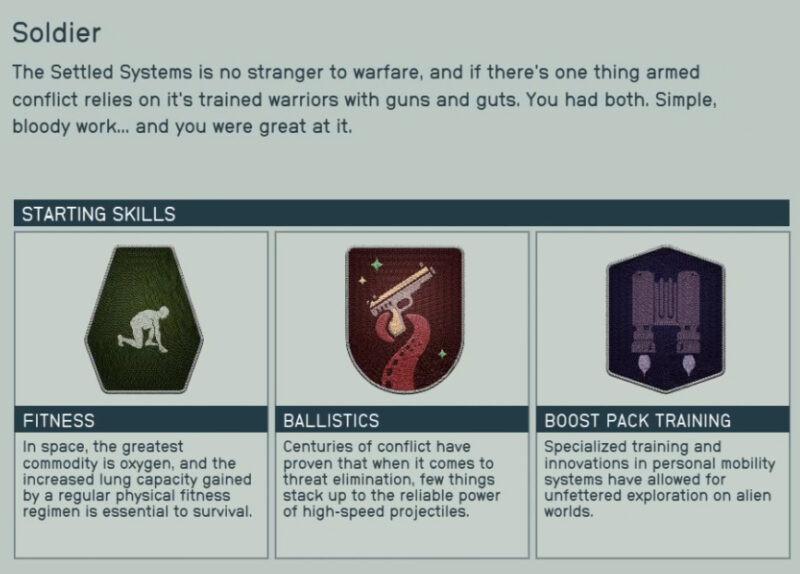
Starfield has 21 backgrounds which act as your “class” along with 16 traits. Traits are optional selections that give you a positive and a negative and these are choices during character creation. Backgrounds will give three starting skills along with other influences on your story. If you don’t like the look of your character at any point you can find an Enhance! store. For 500 credits you can change your character’s appearance.
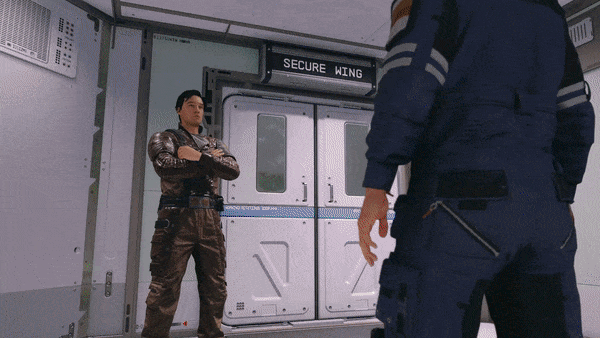
Your background and traits also effect dialogue and have interesting choices in conversations. The main tip I’d give you regarding backgrounds and traits is this: with Starfield having no max level, and you can essentially get all the skills if you play long enough. While your background is important to get three skills initially, what’s most important in my opinion is that your background selection fits your individual story narrative. You don’t want to pick Diplomat then go in guns blazing every time there’s a dialogue option.
Starfield is a story-based game and the reactions you’ll get from your background and traits are priceless and in my personal opinion outweigh the benefit of the three starting skills.
3. Exploring & Story
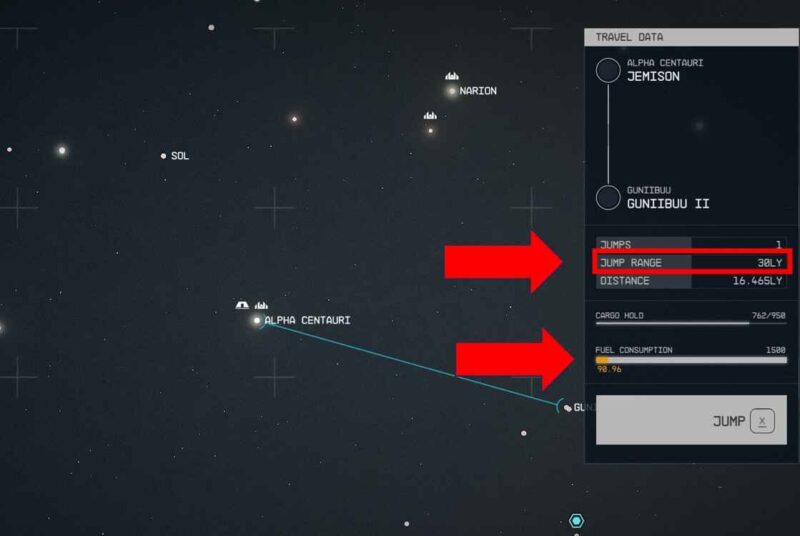
Starfield’s story is set to take place in the year 2330 – a distant, but still imaginable future where humanity has developed settlements on other planets. Twenty years prior to the start of the story the United Colonies went to war with their primary rival for power, the Freestar Collective. Although the Colony Wars are now at an end, the peace between these two factions is an uneasy one. Additionally, the pirates of the Crimson Fleet are aggressively expanding their footholds into systems where they have never been seen before.
The game’s main story centers on a group of explorers called Constellation, who recruit you into their organization. From there, you will be hunting the galaxy for mysterious alien artifacts which seem to hint at a secret knowledge or power. Most of this is, of course, intentionally vague, but early in the game you will gain access to the Lodge. The basement is useful for storage and especially crafting because this area has all the crafting stations.
This is a great location to come and dump all of your resources in the nearby storage crate and pickup only when you need in order to research or craft something. You will eventually want to move your crafting to your outposts, which we will touch on later, but for starters, the Constellation Lodge is going to be your home base.
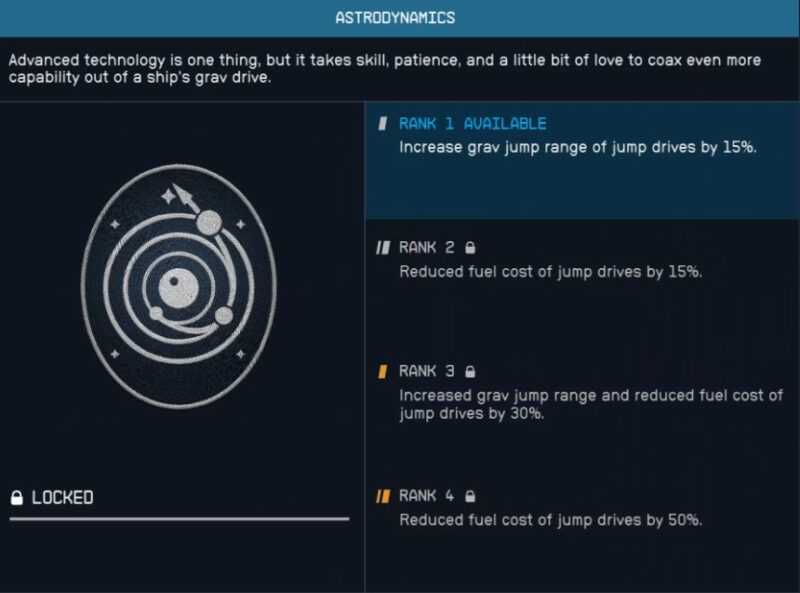
I also wish I would have known that in order to advance the main story is that at some point you will need 21LY distance on your starship. You can increase your gravity jump distance with upgrades to your ship but also the Astrodynamics Science skill. I didn’t have any knowledge of this on my first playthrough and spent no time researching, upgrading my ship or taking the skill. When I hit that point in the game I had to go back and start on those things from square one. You should do this from the start and you’ll find it invaluable for the main story and just quality of life gameplay since exploration is essential and this makes roaming the galaxy effortless.
4. Combat

Starfields combat is up next and it’s a much faster pace and snappier than Fallout 4, another Bethesda title I love. In this game, you will have high mobility with the use of the Boost Pack, along with the typical gun weapons (there are some melee swords and knives available but Starfield is primarily a shooter), throwables like grenades and aid like med packs.
Your character can equip weapons and three types of armor: a spacesuit, a booster pack, and a helmet. Additionally, there is also apparel which offers small bonuses. You will also be able to use companions and crew in combat and there’s an important decision to make regarding these: Are you a lone wolf like me in real life or a social extrovert who likes to work with a team?
For companions, all you need to do is simply recruit them into your party and give them weapons and armor. You need to have them equip it, and even without ammunition they will fire their weapons. I always give my companion a heavy weapon with super expensive ammunition or flashy animations because it’s satisfying watching them destroy everything. They also have a carrying capacity, so it’s equally as nice to bring them to a fight where they can help you with the loot you find afterwards.
The Social skill line Isolation gives you the lone wolf perks of playing solo with increased damage and damage reduction. Leadership in this same skill line will boost your companion’s power and in addition to helping with carrying capacity. I found it ultimately easier to use companions because of the carrying capacity and also not to get lonely.
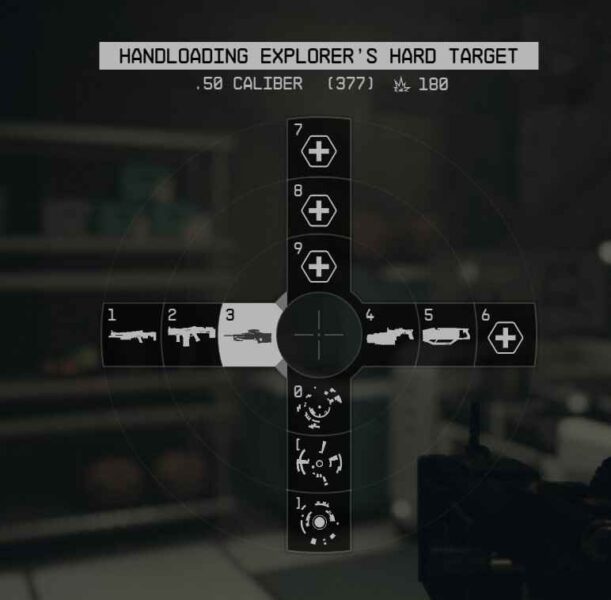
The game will allow quick slots that can be accessed well quickly in combat, I found it helpful to have 3 guns plus a cutter short range, medium and long, and if you have the carrying capacity a heavy for bosses or tough fights. I then use a medpack for healing, along with three aid consumables for damage increase, higher movement speed and or damage reduction. Then you can choose Starborn Powers which are given for main story completion and Temple exploration.
5. Skills
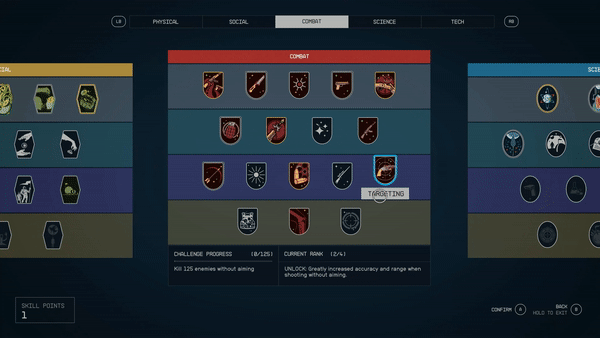
Starfield’s skill system includes multiple skills spread between 5 categories: Physical, Social, Combat, Science, and Tech. Skills from every category will upgrade, customize, and enhance your Starfield character playstyle. Skills can make your protagonist more powerful in combat, more efficient with weapons, a better negotiator and ship pilot, or even increase your base statistics like health and endurance.
Levels in Starfield denote your character progress. Each time you complete a quest, kill enemies, or discover an uncharted planet, you’ll receive experience points. When you gather enough experience, you’ll level up and get a skill point to spend. A quick tip to boost XP is by sleeping in your ship’s bed or any other secured location in Starfield. By doing so you can get an experience boost of 10% extra XP gain for a limited amount of time.
Your background will give you three skills by default, and I recommend unlocking two per skill line you plan to invest in. Combat, Science, and Tech are my favorites due to their application in combat and crafting. My favorite by far skill is Boost Pack Training. This allows you to zoom around combat and non combat situations and speeds up movement dramatically. It’s also very easy to level.
Speaking of leveling, after you unlock a skill, you can rank it up by doing various tasks. For boost pack, simply use boost pack while in combat and you progress the skill. Once you finish your progression you can rank up the skill line at the cost of a skill point up to 4 ranks. The key is that these do cost a skill point, and in my opinion its better to be tactical by taking two skills at the start and focusing on key parts of your build.
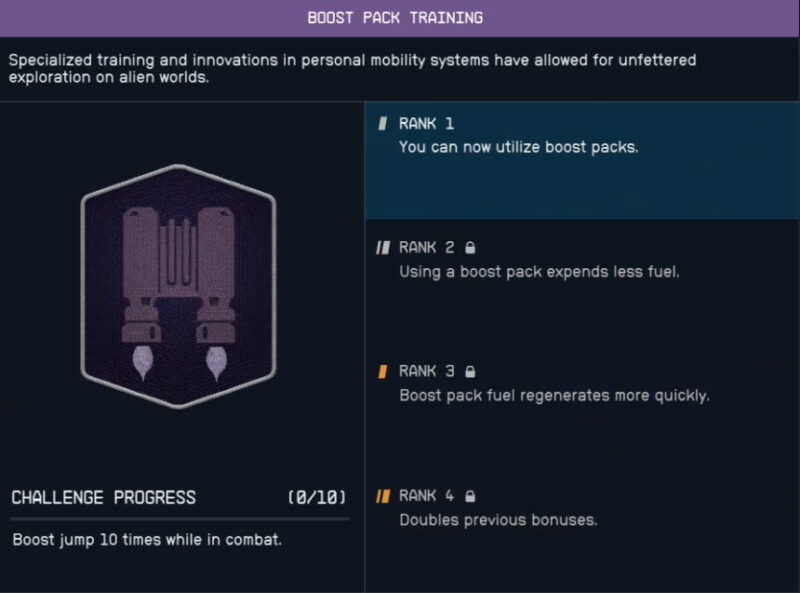
Another factor to consider is you need at least 4 skill points in the previous levels to reach another level. Meaning, in order to take the second line of a skill tree, you need four skill points spent. This could be four skills at rank one, or one skill like Boost Pack Training to rank four. The easiest and most practical is to take two in each skill line and level them up to rank two each.
These are my early skill recommendations for all builds in Starfield:
- Physical Stealth and Wellness
- Social Persuasion and Commerce
- Combat Ballistics and Laser
- Science Astrodynamics and Medicine
- Tech Boost Back Training and Security
Before moving on, you should know that the Science tree is critical for crafting, specifically research. You need to spend 4 points in order to move down the tree and grab Spacesuit Design and Weapon Engineering. If you do not do this, your weapons and armor will be VERY limited, so do not make the mistake I did! Level this skill tree even if it doesn’t appeal to you because at end game it’s all about research, crafting and farming resources.
6. Persuasion
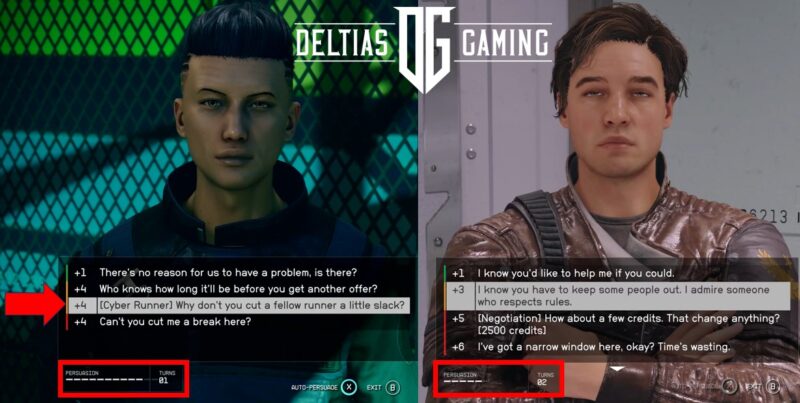
Dialogue and speech checks are a bit more complex than previous Bethesda titles. From the image above, you can see a variety of mechanics. When you enter a speech check, you will have a persuasion bar, turns and then numbers associated with the dialogue options. These will include your background, traits and factions you may or may not be aligned with. The numbers correlate with the grey bars, so if you have four grey bars, you can hit the +4 on the dialogue.
Dialogue can also fail and critically succeed. What I found most helpful when it comes to these options is trying to use all my turns. You want to hit the sweet spot where you end your final turn with all grey bars filled. I also found it helpful to do something in the green or yellow on typical responses. The more aggressive responses (red) are, the more likely the conversation can go sideways and fail.
This system will take some getting used to, but it introduces some randomness and excitement than the standard ‘click a single persuasion option’ and win mechanic. Also consider taking the Persuasion and Intimation skills from the Social skill tree which will help with these options. You will encounter a scenario on Akila City which will test your negotiation expertise, so be sure to save before hand and experiment the responses to get the system down.
One more tip here: there are consumables which provide aid that drastically increase you chances to persuade. Items like Paramour giving a whooping 25% persuasion chance for 10 minutes.
7. Outpost
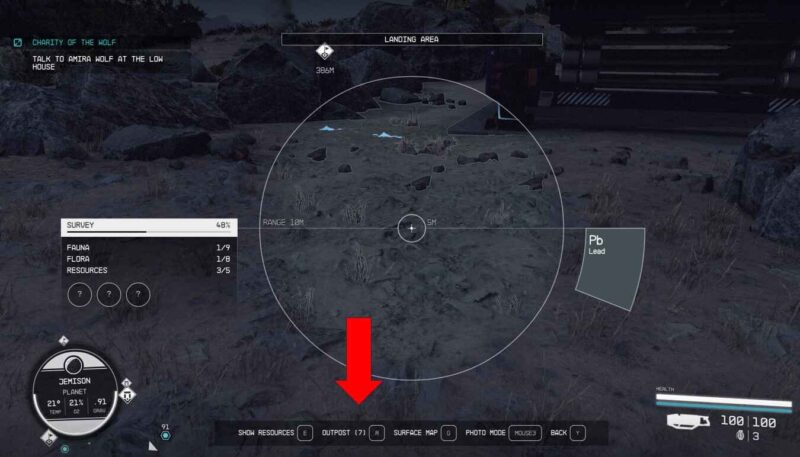
Outposts are similar to Fallout 4 settlements. They serve as your home and main storage area. Outposts take a lot of resources and time in the game to get fully optimized, BUT it’s well worth it. Throughout the game, you will collect resources which are essentially minerals, materials, and other apparent junk that you’ll initially put into your ship’s storage, and then eventually move to your outpost storage.
Here is a good picture that shows your loot but the text below indicates its resources, which are essential to many mechanics in the game like building up your outpost.
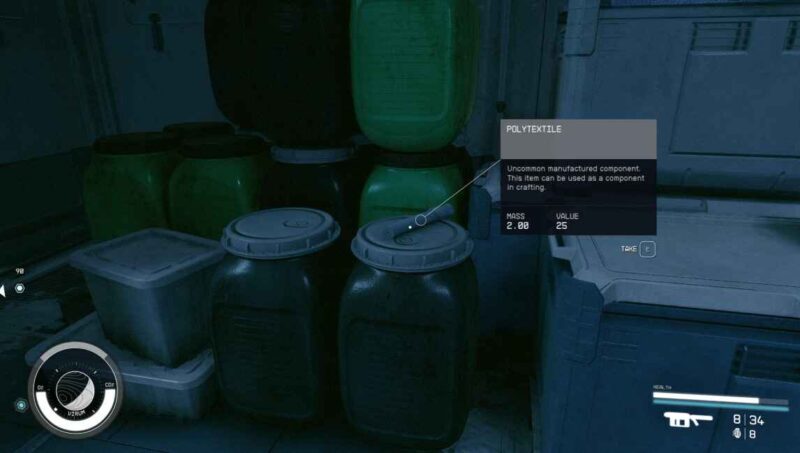
What’s mind-blowing about outposts is you can set them almost anywhere on worlds or moons. At first, you will be limited with builds, but the Planetary Habitation skill allows you to increase your outpost building and the conditions where you build. I found it extremely helpful to build my first outpost just outside of New Atlantis since you will constantly travel to this location for quests. You can then haul all your materials from the Lodge to your outpost and begin massive research and weapon modifications.
Additional helpful tips:
- Build a ship landing pad near your crafting stations. This will save time transporting goods. Additionally, craft the landing pad with shipbuilder if possible.
- You’ll want to craft a Self-Service Bounty Clearance. In the game there’s contraband which you can obtain and sell at sedey vendors. This system could take up its own guide, but for now just know that it’s a pain to clear this manually without this object.
- I HIGHLY recommend building a Transfer Container unit. This will allow you to transfer ship cargo to your storage contains. Your cargo storage will fill out fast once you start crafting and collecting resources, and this saves you loads of time.
- Get the cargo link or cargo link intersystem if you plan on doing multiple outposts (and you will). If you haven’t gotten my drift yet, storage and resources are a lot of the gameplay necessary in order to expand on your crafting and research. These things will make the game much more enjoyable when everything is linked and storage is shared.
- You most have a research lab setup – I will address this in more detail below.
8. Starship

Next up are spaceships – or Starships, as they are referred to in the game. One is given to you as part of the main story quest, but you can also purchase additional ships, as well as commandeer them, which is really cool! Consider starships a late or end-game activity, which at first can seem like another overwhelming system. It’s something you do want to focus on because it helps with the main story progression and specifically exploring, which is limited by how many light years you can jump.
Ships cost credits to buy and upgrade and it can be very expensive. Each ship has gravity and fuel range as well as reactors and all sorts of other features. You’ll power the systems manually, by moving over to the various sections and going up or down. There will be 3 weapons if equipped, engine, shield, and gravity. Sometimes your grav drive will be powered down and this is usually the first thing you want to max out, alongside shields. You can then increase your reactor capacity to increase your overall power in these individual categories. But at the start, just keep an eye on shields and grav and reduces weapons to keep these high for non-combat situations.
Priority early in the game is to upgrade shields, reactor, and gravity drive. Once you get more credits then start optimizing weapon systems to have multiple types. For example, have one or two weapons for lowering shields and another like missiles for damaging a hull.

The Tech skill tree is saturated with skills to level up your starships. If you plan on doing bounty hunting you should select Target Control Systems, which allows you to target specific systems in order to disable an enemy ship. You can then board, capture or kill the crew and take their starship for yourself.
The first time I did this, I freaked out that my previous ship was lost. But don’t worry – it’s not. A in-game mechanic will return the ship port and you can land and register your new ship in order to add it to your collection. You then can swap your home ship to whichever one you want.
Another thing to keep in mind is that when you’re traveling and especially landing in United Colony territory, you may want to make sure there’s no contraband on your ship. The UC fleet will scan you and sound the alarm if they find something suspicious on board.
Lastly, if you get panicky when jumping into a system, you can jump out. Often times you will encounter a lot of cool scenes as soon as you enter a new system. If you get attacked and don’t know what to do, power up that grav drive to the max and select a system to jump to before they target your starship.
9. Research
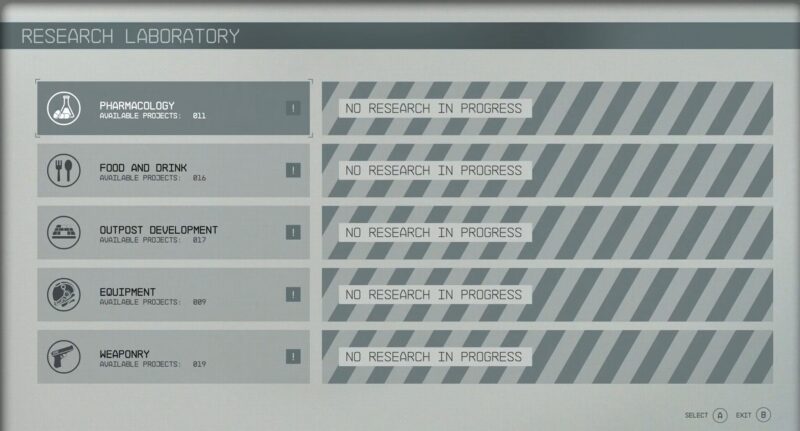
After you’ve gotten your outpost setup, and resource-swapped collected materials to your outpost it’s time to start researching.
Research comes in 5 categories: Pharmacology, Food and Drink, Outpost Development, Equipment, and Weaponry. You can assume each of these categories has corresponding skills that need to be unlocked and progressed in order to advance your research knowledge.
To research something, you simply need the material and the required skill. Input the materials that consume them from your inventory or storage until all conditions are met and learn that specific research.
The first time I played, I didn’t focus on research at all. I hit level 20 with zero skill points in Weapon Engineering and Spacesuit design. My weapon power quickly faded and I was left with random weapons that I couldn’t upgrade and modify. And as you can see, there are MANY systems that tie together to make this happen.
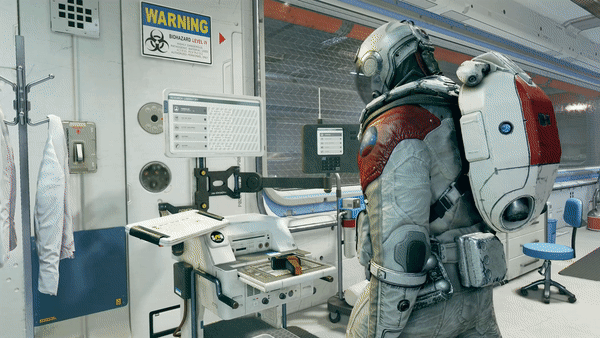
Here are the basic steps to advance your Research projects in Starfield:
- Learn the skills early, even if you don’t want to advance the Science tree much
- Build an outpost and unlock the research station
- Haul resources to your storage and link your starship with the outpost
- Rank up crafting skills of your choice
- Start researching and unlocking upgrades
Once that research is completed, you are then allowed to modify an item. Weapon mods are so important because you can take an old beat-up, seemingly useless weapon from early in the game, and turn it into a dream gun with armor-piercing rounds, a long barrel for huge range and high-powered internal components for nearly double the damage.
Additionally, you don’t want to miss out on the consumables that help with reduced cost on research. Neurajack specifically gives lower research cost and +50% chance of sudden developments for 10 mins. Save this up along with materials for a massive research project.
10. Making Credits
After I beat Starfield for the first time, I quickly started over with a New Game+. I won’t spoil any of that for you, but needless to say, I made every single mistake on the first playthrough, and making credits was one of my biggest issues. Here’s some tips for how to do it right.
First, loot everything at the start of the game, and bring a companion along for over 100 mass or weight of storage. Look for low-mass items that sell for high credits, which are weapons typically. Spacesuits weigh a ton so be careful if the credits are listed low.
After each mission or encounter, you want your companion and you to be full of loot to sell. Most likely you will be constantly encumbered at the start, which will cause your O2 to deplete and build-up up C02 which will cause damage. To counteract this simply stand still for a while before continuing – you won’t be able to fast travel while encumbered. Additionally, you can use a Jet Pack Boost to mitigate some of this O2 loss by boosting around vs. sprinting and draining your 02.
You will quickly find vendors with low credits (around 5k at the start of the game) and selling a handful of weapons to them will quickly get you some or most of those credits. You want to then buy any resources you need like nickel, adhesive, iron, and titanium, which are great for research early on. Then sell until they are out of credits, you rinse and repeat this process with every vendor in every city.
In general, vendors will only buy from you the same types of items they sell. So you want to make sure to sell weapons to a weapon vendor and NOT the general trader. Otherwise, you will have 20 maelstrom guns to sell and no one on that planet and in the city to buy them.
You can also offload ammo you don’t plan on using. I recommend carrying 3 guns plus a cutter: 1 short-range shotgun, a medium-range like an AA-99, and a long-range like the Hard Target. Then you have tons of credits used for resources mainly, which allows you to level up your research and mods, followed by leveling up your starship.
Here are the basic tips for making credits in Starfield:
- Do combat-based activities like finding a miscellaneous weapons factory that’s supposedly ‘vacant’ (AKA full of pirates)
- Clear out the bad guys, loot everything and if you can walk back to your ship, do so encumbered filled with weapons, armor, and supplies
- Go to the three early game planets that have tons of vendors: New Atlantis, Akila City, and Neon.
- Sell armor to the general merchant, weapons to the weapon vendor, and so on. Buyback resources and offload all of your material
- Return to your ship and store as much as possible in storage containers, then return to the outpost
- Build more storage, store resources, and continue to research and mod weapons
- Once mods are unlocked, research done, start upgrading your ship for end game content
Looking For More About Starfield?
Thank you for reading my Starfield: Tips I Wish I Knew First – New Player Guide. We provide the latest news and create guides for Starfield. Also, watch me play games on Twitch or visit my YouTube channel!
 Reddit
Reddit
 Email
Email
